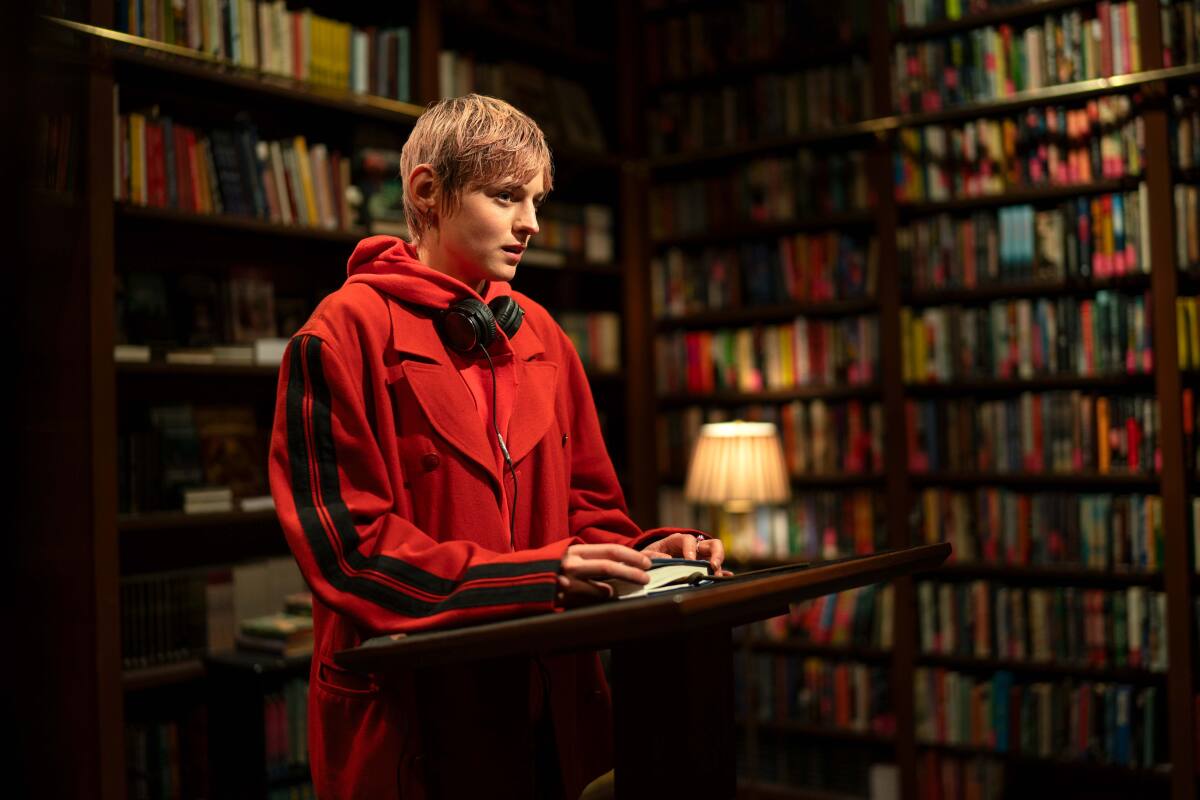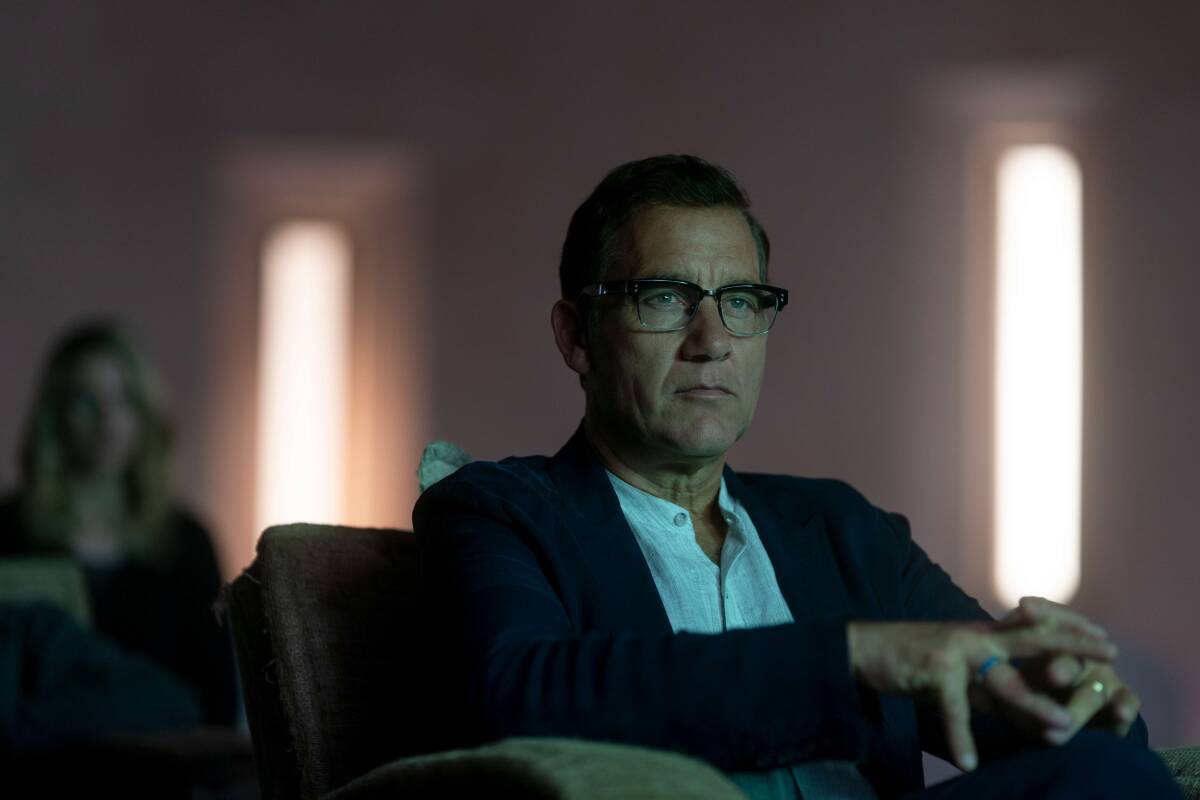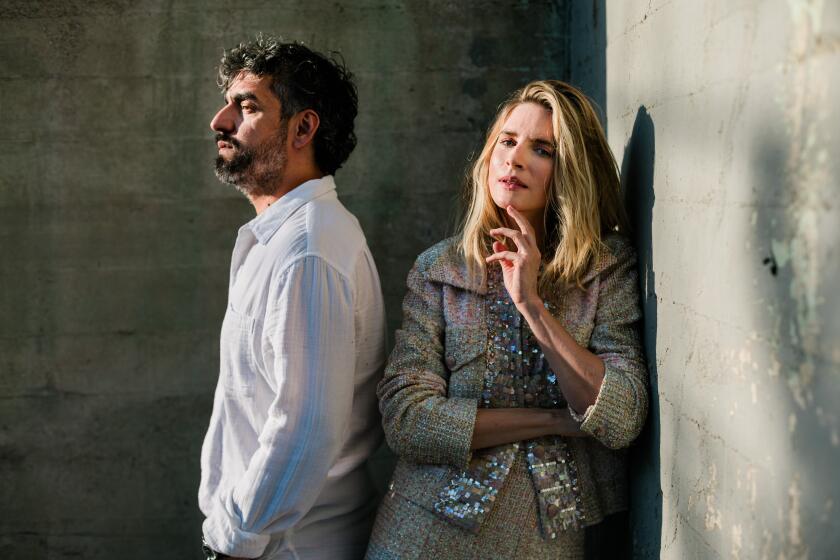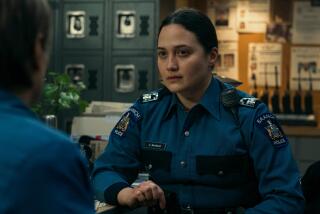In ‘A Murder at the End of the World,’ Emma Corrin is an electric presence

Beneath its contemporary trimmings and 21st century themes, the most excellent “A Murder at the End of the World” (FX on Hulu, premiering Tuesday), from Brit Marling and Zal Batmanglij (“The OA”), is as conventional as can be — the nth-hundredth variation on an Agatha Christie-style country-house/isolated island mystery, in which the killer, the victim(s) and all the sundry suspects are cooped up in a single location from which no one is able or allowed to leave. Tropes of the genre abound, including a creepy butler, though he exists only as an avatar of artificial intelligence.
The story’s Nancy Drew (the other timeless literary touchstone), with a touch of Thom Yorke, is Darby Hart (Emma Corrin), a 24-year-old hacker and author, whose bleached bob recalls that of genius coder Mackenzie Davis in AMC’s “Halt and Catch Fire.” With her careless style and complicated emotions — she’s kind of shy (except where crime-solving is concerned, when she charges ahead), something of an outsider, a lonely loner — Darby is the model of a manic-depressive pixie dream girl.
For the record:
1:55 p.m. Nov. 15, 2023An earlier version of this review said “A Murder at the End of the World” is on FX. It is on FX on Hulu.
Brit Marling and Zal Batmanglij, the creators of FX’s “A Murder at the End of the World,” wanted to create a detective who was more evolved than what we typically see in the whodunit genre.
It’s not Radiohead coming through her headphones as she makes her way along the streets of a city, but the Doors’ “The End,” which every film-literate person knows is a nod to the opening of “Apocalypse Now,” and it’s not the last time, watching this seven-episode series, that you might think of a 20th century film. Darby has come to a bookstore to read aloud her middling-selling true-crime memoir of how she solved a cold case six years earlier, alongside liberally tattooed Bill Farrah (Harris Dickinson), whom she met through an online network of amateur sleuths. “The L.A. Times called her Gen Z Sherlock Holmes,” someone will say. (We get a chuckle out of such references, but it doesn’t affect the review.)

Out of the blue, Darby receives an invitation to join a small group of big thinkers on a retreat held by Andy Ronson (Clive Owen), a tech billionaire in the recognizable modern mode; spaceflight, extraterrestrial colonization and AI, which he prefers to call “alternative intelligence,” are among the pies in which he has his fingers. Soon she is boarding a private plane to Who Knows Where, on which she’ll encounter the first of her fellow conferees: Lu Mei (Joan Chen), who designs “smart cities” in China; director Martin (Jermaine Fowler), who is utilizing AI on a movie; Sian (Alice Braga), who has walked on the moon, because in this fictional world that’s something a person younger than 88 has done; and Ronson’s business associate David (Raúl Esparza).
They fetch up in an isolated, snowclad region of Iceland at Ronson’s new, saucer-shaped boutique hotel, where we meet his other guests — robotics genius Oliver (Ryan J. Haddad), Iranian activist Ziba (Pegah Ferydoni), off-the-grid climatologist Rohan (Javed Khan) — along with Ronson’s wife, Lee (Marling) — a renowned older-generation hacker and the main attraction for Darby — and their 5-year-old son, Zoomer (Kellan Tetlow), who at least is not named Techno Mechanicus. The hotel’s small human staff is supplemented by the aforementioned virtual butler, Ray (Edoardo Ballerini), who is everywhere.
And last but not least, arriving late to dinner, is Darby’s old friend Bill, whom she has not seen in six years, since they fell in love, caught a serial killer and he disappeared, leaving a note written on a mirror: “I think this is both too much and not enough.” In the interim, he has become a famous anti-tech guerilla artist who goes by the handle Fangs, which doesn’t at all sound like Banksy. This transformation is actually the least plausible element in a story full of fantastic elements.
By the end of the first episode, one of these people will be dead. Darby, whom no one takes seriously, because she’s only 24 and not as famous as everyone else, suspects murder — but, as often happens in these stories, no one else thinks so until a second murder confirms the first.

Alternating with the Iceland story are flashbacks to Darby growing up as a teenage weirdo assisting her medical examiner father after school back in Lost Nation, Iowa, hanging out at crime scenes and in the morgue, and her growing relationship with Bill, whom she meets online and with whom she’ll hit the road in search of a serial killer. While not explicitly linked to the present-day mystery, it gives it an emotional resonance and brings depth and dimension to Darby’s character. The point in these earlier scenes is less about solving a crime than the Mystery of the Human Heart, and how the couple’s sometimes reckless adventures will bring them together and drive them apart. And practically speaking, it adds tonal variation; it lets the series breathe. It gets you out of Iceland.
As with every good mystery, where we end up matters less than how we get there, how the story draws you in, makes you care, gets you scared, and keeps you guessing until the end. (Although, for anyone versed in the game, there is always the possibility you might come to some conclusions before the detective does; and clues are left here in plain sight.) Indeed, the end even of a great mystery can feel like an anticlimax.
The art is in making the formula distinct, coloring it in with interesting characters set against an appealing, which is not necessarily to say pretty, background. Beautiful without being self-consciously stylish, stealing a little Scandinavian aesthetic without involving any Scandinavians, “A Murder at the End of the World” moves slowly but remains compelling, and it’s often suspenseful, whether we’re digging up the floor in a dark Midwestern basement, driving too fast on an icy road or stuck in a fancy hotel that might be watching its guests like a house haunted by nosy spooks.
The series throws around a few big ideas about artificial intelligence, addiction to technology, the climate crisis — “the end of the world” can be taken geographically or temporally. It also makes some socially responsible points about the tens of thousands of murders, mostly of women, that remain unsolved, and the lengths to which rich people will go to control their world, if not The World. But the series is not in any substantial sense “about” those things.
More than anything else there is Corrin, who played Princess Diana in the fourth season of “The Crown” and has an electric presence even in repose. When Darby’s head first fully emerges from her hoodie in the series’ opening scene, it’s as powerful a reveal as any to follow; something tells the viewer that this will be a trip worth taking, and the camera, cooperatively, spends a lot of time close to her face. It also reflects her point of view — a view that at one point will be fractured — and how she regards and fits into any space where fictional detectives are often merely instruments over whose shoulder we watch a puzzle being completed, Darby remains very much at the center of the story. Go find her there.
More to Read
The complete guide to home viewing
Get Screen Gab for everything about the TV shows and streaming movies everyone’s talking about.
You may occasionally receive promotional content from the Los Angeles Times.








